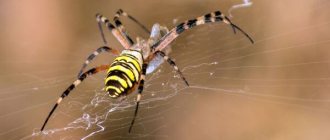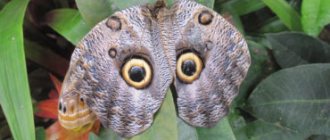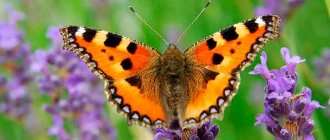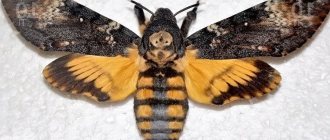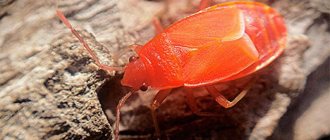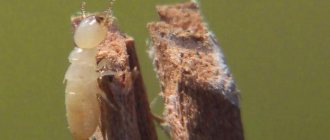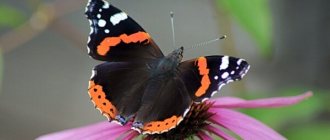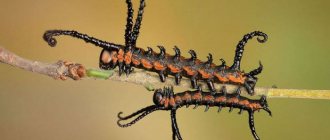- Wild animals
- >>
- Insects
The Swallowtail butterfly is one of the most beautiful daytime butterflies in our mid-latitudes. Due to its sophistication and exclusivity, the insect is considered a desirable acquisition for collectors and moth lovers. These amazing creatures are known to almost everyone. Bright colors and large sizes give butterflies grace and uniqueness.
Origin of the species and description
Photo: Swallowtail Butterfly
The species Papilio machaon belongs to the family of sailboats (Latin: Papilionidae). The species was discovered by the Swedish naturalist in 1758, Karl Lyney. The biologist named the butterfly in honor of the ancient Greek physician Machaon, who was a physician, surgeon and fought for the Greeks in the Trojan War (1194 BC). The doctor was the son of Asclepius (god of healing) and Epione.
Interesting fact: There is a legend that Doctor Machaon healed warriors wounded in battle. He took part in the Battle of Troy to win the hand and heart of Helen the Beautiful. But when he dies in one of the battles, his soul turns into a beautiful yellow butterfly with a black pattern on its wings.
Since the swallowtail's range is quite wide, up to 37 subspecies of the moth are distinguished. The most common among them:
- Orientis - south of Siberia;
- Ussuriensis - Amur and Primorye;
- Hippocrates - Japan, Sakhalin, Kuril Islands;
- Amurensis - basin of the middle and lower Amur;
- Asiatica - Central Yakutia;
- Kamtschadalus - Kamchatka;
- Gorganus - Central Europe, Caucasus;
- Aliaska - North America;
- Brutannicus Seitz - Great Britain;
- Centralis - Caucasian coast of the Caspian Sea, Northern Caspian Sea, Kura Valley;
- Muetingi - Elbrus;
- Syriacus - Syria.
There are other subspecies, but scientists do not recognize many of them, considering them only seasonal forms similar to the nominate individuals. The dependence of the color of wings on temperature does not allow taxonomists to come to a common opinion, as a result of which there is constant debate on this topic. Externally, the appearance is similar to the Corsican sailboat and the Alexanor sailboat.
Swallowtail butterfly: description and habitat
The majority of the population of our country has heard the name “swallowtail”.
This butterfly is known to many. What may seem strange here is that most people have never heard the names of other species, namely swallowtail, many people have heard of it. Perhaps the reason is that this individual is very beautiful and large in size. In some countries it is listed in the Red Book, as the swallowtail population is rapidly declining. The swallowtail butterfly got its name from the famous biologist and naturalist Carl Linnaeus. He became the founder of the taxonomy of the animal world. When Linnaeus saw this then unknown butterfly, he named it in honor of the son of Aesculapius Machaon, the famous mythical doctor of the Trojan War, who saved many human lives and alleviated people's suffering. Swallowtail is a large representative of the order Lepidoptera. Belongs to the sailboat family.
Appearance and features
Photo: Machaon
The color of the swallowtail is bright and beautiful - yellow or beige. On top of it is a pattern of black lines. Body size reaches 10 centimeters in females and 8 in males. The wingspan is from 6 to 10 centimeters, depending on the subspecies. Along the outer edges of the wings there is a pattern of moon-shaped yellow spots.
The hind wings have elongated tails that are not adjacent to the abdomen. Their length can reach up to 10 millimeters. The sides of the wings are framed by blue and yellow spots. There is a red “eye” on the inside of the wings. Life expectancy is up to 24 days.
Video: Swallowtail Butterfly
The caterpillars hatch green with black stripes containing many red dots. Their body length at birth is about 2 millimeters. In the prothoracic segment there is a fork-shaped gland that forms orange “horns”.
Interesting fact: “Horns” serve as protection against natural enemies. The gland emits an unpleasant odor that repels predators. Caterpillars lie curled up in a ball most of the day. They disguise themselves as bird droppings so as not to attract the attention of birds.
Pupae can be gray or green. The last generation always overwinters in the pupal stage. The adult is born in the spring, when all the frosts have passed. For the first half hour, they dry the wings and thaw, and then scatter throughout the area.
So we figured out what the Swallowtail butterfly looks like. Now let's find out where the Swallowtail butterfly lives.
Reproduction and lifespan
Spring is considered a favorable period for butterflies to breed. They spin in the air as if they are dancing. During this period, they gather in flocks, but then scatter again. After mating games, the female lays eggs on a leaf or stem of a food plant. In one season, a female can lay up to 120 eggs. A week later, caterpillars emerge from the clutch.
.
They are distinguished by their black color with white or red spots, but as they develop, their color changes. The swallowtail caterpillar has a unique means of protection against predators on its head. These are two glands that are not visible in a calm state, but at the moment of danger two orange tubercles appear. They give off an unpleasant odor
, capable of scaring away a predator.
To survive the winter cold, the caterpillar pupates and spends the winter in this state. The lifespan of the swallowtail butterfly is on average 20 days, so three generations can replace each other over the summer.
Where does the swallowtail butterfly live?
Photo: Swallowtail Butterfly
This species inhabits almost every corner of the Earth. Insects can be found in North America, southern India, North Africa, the islands of the Indian Ocean, throughout Asia; in England, moths live only in the lands of Norfolk County and in the territory extending from the Arctic Ocean to the Black Sea.
The Swallowtail butterfly can live in almost any conditions; any climate suits it. The butterfly was encountered in the mountains of Tibet at an altitude of 4500 meters above sea level. Such a wide geographical distribution has led to such a wide list of subspecies.
Insects love open spaces, so they prefer fields, forest edges, steppes, gardens, and tundras to polluted, noisy cities. Moths can fly at a height of 2.5 to 4 meters. They do not stay on one plant for a long time, so naturalists nicknamed them energetic butterflies.
In the north of their range, these beautiful creatures can be found in the summer; in the southern regions, the species is awake from May to September. Lepidoptera prefer not to migrate, but to stay in their native lands for the winter. Particularly large accumulations are observed on lands sown with carrots, caraway seeds, fennel, and dill.
The Orientis subspecies prefers the southern climate, Asiatica prefers the northern climate, Gorganus chose a moderately warm one. Brutannicus prefers humid environments, while Centralis and Rustaveli prefer mountainous areas. In general, the species chooses sunny areas with an abundance of flowers.
What does the swallowtail butterfly eat?
Photo: Machaon
As soon as the caterpillar is born, the insect immediately begins to eat the leaves of the plant on which the egg was laid. The caterpillars feed very actively, making a significant reserve of energy precisely at this stage. Most often, umbrella species become food for species in the middle zone, such as:
- Parsley;
- Dill;
- Caraway;
- Carrots (wild or regular);
- Hogweed;
- Buten;
- Angelica;
- Prangos;
- Gorichnik;
- Fennel;
- Reznik;
- Celery;
- Bedrenets;
- Cutter;
- Girchovnitsa.
Inhabitants of other regions feed on plants of the Rutaceae family - hairy ash, Amur velvet, various types of whole leaf; Compositae: wormwood; birch: Maksimovich alder, Japanese alder. Towards the end of its development, the caterpillar's appetite decreases and it practically does not eat.
Adults feed on nectar, like most other butterflies, thanks to their long black proboscis. They are not as picky eaters as caterpillars, so they choose not only umbrella plants. To find food for themselves, moths visit different flowers.
Adults do not require a large amount of food; just a drop of flower nectar is enough for them, and they quench their thirst with morning dew. Lepidoptera obtain all the microelements necessary to maintain a tiny organism from soil containing salts or from the waste of other animals.
Features of character and lifestyle
Photo: Swallowtail butterfly from the Red Book
Butterfly activity occurs during the daytime. They also pollinate flowers that bloom only during the day. Adults live only a few weeks and, after fertilization (males) and laying eggs (females), the moths die. The summer period lasts from May to June and July-August; the southern subspecies can be found in September.
Swallowtails are very active creatures. Even when feeding with nectar, they do not fold their wings in order to fly further at any second. Individuals prone to migration fly into cities and settle in park areas, garden plots, and lawns rich in flower plants.
To find the most comfortable living conditions and places with a good food supply, moths are ready to travel vast distances. Most individuals produce two generations in a lifetime, in the north of the range - one, in the south - up to three. Adults are preoccupied with breeding offspring and try to find a partner as quickly as possible.
Interesting fact: The caterpillars of this species have impressive mouthparts. They begin to eat the leaf from the edges. Having reached the central vein, they move to the next one. They gain weight very quickly. But as soon as the individual pupates, growth is completed. Moths only need energy to fly and reproduce.
Social structure and reproduction
Photo: Swallowtail Butterfly Caterpillar
Since nature has given swallowtails very little time to exist, only newly born butterflies immediately begin searching for a partner. Pairs find each other thanks to the production of a pheromone, which they release into the environment.
During her short life, the female manages to lay 100-200 eggs. With each approach, she lays 2-3 spherical, light yellow eggs under the leaves or on the stems of plants. After about a week, the eggs darken and change their color to black.
Females deliberately lay one egg on different plant leaves to provide food for the newborn caterpillars. After 8-10 days, the larvae hatch and first begin to eat. At the age of about 7 weeks, the caterpillar is attached with a silk thread to the stem of the plant, the last moult occurs and the individual pupates.
The pupae remain motionless for 2-3 weeks, after which they turn into an adult butterfly. In the cocoon, most of the caterpillar's organs are destroyed, transforming into the organs of an adult. The process is reminiscent of digesting your own body in a cocoon.
Summer pupae are predominantly green, wintering ones are brown. The butterfly will remain in the pupal stage until the first warm days. When the cocoon cracks, a beautiful creature is born. The moth sits in the sun for some time and dries its spread wings, after which it goes in search of food and a partner.
Natural enemies of the swallowtail butterfly
Photo: Swallowtail Butterfly
At all stages of the insect's life cycle there is danger. The Swallowtail butterfly can become food for arachnids, birds, ants, insectivores, and small mammals. Moths are most vulnerable in the caterpillar or pupa stage. The insect manages to avoid attacks thanks to its camouflage color.
When young, the caterpillar looks like bird droppings. After the next molt, black and bright orange spots appear on the body. The colorful appearance lets predators know that the insects are not suitable for consumption. If the caterpillar senses danger, it begins to emit an unpleasant putrid smell with its horns, indicating that its taste is disgusting.
On the hind wings there are red-blue spots with a black border, resembling eyes in appearance. When the wings are spread, these spectacled spots discourage predators who want to feast on the moth. The effect is secured by elongated processes at the tips of the wings, reminiscent of tails.
Seventy years ago, moths were considered pests due to their consumption of human-grown plants. People destroyed butterflies in every possible way, treating fields with poisons and chemicals. Because of this, the number of the species quickly decreased and meeting this fluttering creature became a problematic task.
Swallowtail butterfly. Lifestyle and habitat of the swallowtail butterfly
The swallowtail butterfly is a very beautiful, large daytime butterfly of the swallowtail (cavalier) family. The wingspan of male swallowtails reaches 8 cm, in females 9 - 10 cm. As is typical for all day butterflies, the antennae of the swallowtail are club-shaped.
On the hind wings there are tail-like outgrowths up to 1 cm long. The color of the wings of the swallowtail butterfly is yellow, with a black pattern; the hind wings may have blue and yellow spots, and they also have a bright red “eye” in the inner corner of the wing.
If you look at a photo of a swallowtail butterfly , you will notice how much the shades of its wings vary - from pale sand, almost white, to bright yellow.
This is due to the fact that the color of the butterfly depends on the climate in which it lives. In the northern part of its habitat, the color is quite pale, with a very strong black pattern on the wings.
While the southern individuals of the swallowtail butterfly are much larger and have intense yellow wings, and the black pattern on them is more subtle.
Population and species status
Photo: Machaon
The number of swallowtails is small and is directly related to the destruction of their natural habitats. On the territory of Russia, populations are considered small. Subspecies living in areas running along railroad tracks and reclamation canals are exposed to poisoning by pesticides.
The greatest damage is caused by the burning of autumn grass, which has become catastrophic on a massive scale. When grass is burned in the spring, a huge number of pupae that overwinter on plant stems are destroyed. Summer mowing of grass along highways also causes significant damage in terms of numbers.
Some of the blame falls on collectors who want to get as many rare endangered species into their collections as possible. They catch individuals either for personal sets, or for exchange with other butterfly lovers from different countries. But no one collects statistics, as well as data on the amount of damage.
Natural problems include cold weather conditions, low temperatures, early frosts, due to which the individual does not have time to pupate, and prolonged autumn, which leads to damage to the larvae by fungus and parasites. Declines in numbers are observed throughout Europe. In some countries the species is protected.
Swallowtail protection
On the territory of the Russian Federation, depending on the region, there is a low or average number of swallowtails. In the Vologda, Moscow and Smolensk regions, this species is at the stage of extinction, so it is listed in the Red Book. The factors that cause a decrease in the number of butterflies are economic and natural. The latter include unfavorable climatic conditions - low temperature and cloudy weather during mating and laying eggs, damage to autumn larvae by rain and fungal diseases, the influence of early frosts that kill the pupa at the stage of transformation into an adult.
But humans also bring a lot of harm to the swallowtail. Frequent fires in forests and burning of grass lead to the death of butterflies. They also die due to the treatment of agricultural land with insecticides and the capture of individual individuals for collecting. Caterpillars that feed on crops are also destroyed.
A reduction in the number of swallowtails is observed not only in Russia, but throughout Europe. The insects are protected in Latvia, Lithuania and Germany. In these countries, it is prohibited to catch butterflies and collect their caterpillars and pupae. There is strict control over the regularity of cattle grazing and the use of chemicals for treating plants.
There are several interesting facts about this type of insect:
- the Germans decided to draw attention to the endangered species and in 2006 made the swallowtail a symbol of the state;
- colored eyes and tails on the wings are necessary to distract the attention of birds of prey from vital organs;
- at the end of August, the patterns on the insect’s body fade and become faded;
- at the slightest alarm, the butterfly begins to quickly flap its wings, trying to fight off the attacker;
- The intensity of the color directly depends on the climate: the higher the air temperature, the brighter the swallowtail will be.
